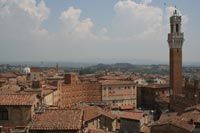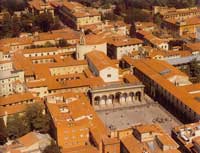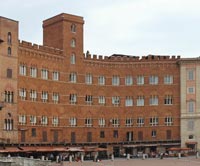| |
|
| |
|
|
|
|
|
|
| |
 |
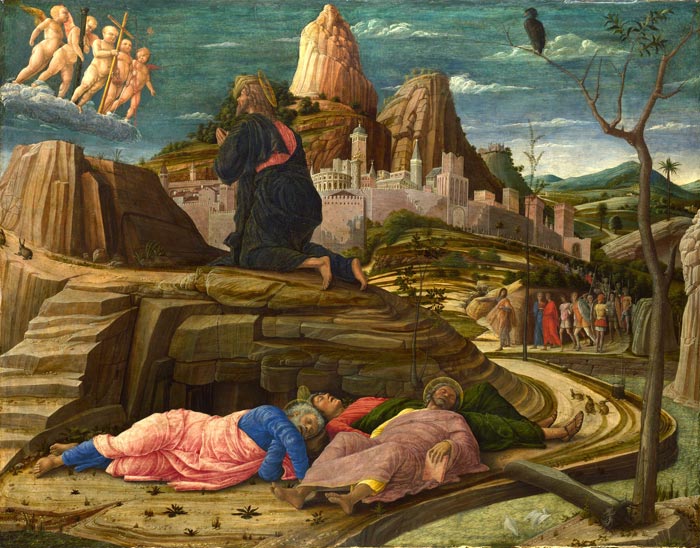 |
Andrea Mantegna, The Agony in the Garden, about 1458-60, The National Gallery, Trafalgar Square, London
|
|
 |
 |
| |
|
|
|
| |
|
Andrea Mantegna, The Agony in the Garden
|
|
|
|
| |
|
In 1453, Mantegna married Nicolosia, Giovanni Bellini’s sister, thus forming close links with the most important painting workshop in Venice, run by his father-in-law Jacopo Bellini. The intense exchanges of ideas between the two brothers-in-law and the resulting influences were to have fundamental repercussions on the destinies of painting in Northern Italy.
Both he and his new brother in law, Giovanni Bellini, used a drawing of Jacopo's as a basis for an Agony in the Garden (c 1455, both London, National Gallery): a comparison of the two reveals the fundamental difference between Mantegna's sculptural conception and the new conception, that of forms modelled by colour and light, their edges softened by atmosphere, that Giovanni was to evolve for Venetian painting.
If Jacopo remains faithful to his visionary landscapes, to the late Gothic world, Giovanni shows himself, early on, receptive to Donatello’s art, for example in the predella relating episodes of the life of Drusiana. The miniatures of the Passion of Saint Maurice, Strabo’s Geography and of the Madonna of Pavia also show Mantegna’s ascendancy, but this was to be short-lived. As from 1460, with the moving Blessing Christ which, with its brilliant matter and pathetic inspiration, testifies the seduction exercised by the Flemish masters, in particular Rogier van der Weyden, Giovanni is in complete possession of a personal style.
Of the different figures making up the Saint Luke altarpiece, undertaken by Mantegna in 1453, the Saint Justina shows best Giovanni Bellini’s tender vein, as does the Virgin and Child with two saints whose style places it in the same period.
|
Angels bearing the Instruments of the Passion appear to Christ at prayer. The disciples sleep. In the background Judas comes with soldiers to arrest Christ. The dead tree and vulture may indicate death. New growth and the pelicans are perhaps hopeful signs for the future. Jerusalem (which is represented here as a walled city), and which was then under Roman rule, includes an equestrian statue, a column with relief sculpture, and a theatre like the Colosseum, all inspired by monuments surviving in Rome.
The other version of this picture by Mantegna is in Tours (Musée des Beaux-Arts) and is firmly dated to 1457-9, although the composition is in reverse, and the disciples differently arranged.
The National Gallery picture is probably a little later in date. It is more fluent as a composition and more dramatic in presentation, with a more effective relationship between figures and landscape.[1]
|
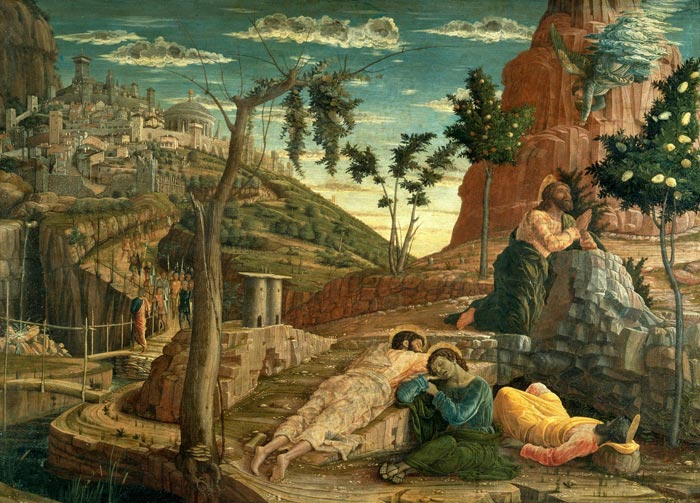
|
Andrea Mantegna, The Agony in the Garden, 1457-1459, Tours, Musée des Beaux-arts
|
| From 1456 to 1459, Mantegna devoted himself to the monumental altarpiece commissioned by Gregorio Correr, abbot of the Benedictine monastery of San Zeno in Verona. The main panels are still in place on the high altar of the church, while the predella elements are divided between Tours and Paris. To place his personages in an all'antica vestibule running along the whole width of the main register, Mantegna took as his model Donatello's bronze altar in the Basilica of Sant'Antonio in Padua. He pushes illusionism to such an extent that he makes the natural light of the edifice, falling from a window to the right, correspond to that of the painting's fictive space, and juxtaposes the columns of the carved frame with the pilasters of the painted loggia.
The three predella panels show his fascination for the art of Flemish masters, examples of which he could have seen in Venetia: as in the Adoration of the Shepherds he multiplies realistic notations. The deep sense of nature transpiring here, the gentleness of some personages owe much to Giovanni Bellini, to whom Mantegna is still very close. But after this moment of intense poetry, he returns to a more austere and cerebral style, adopted a few years earlier in the Agony in the Garden in London. |
|
|
|
| |
|
|
|
|
|
|
|
|
|
|
|
|
|
|
|
Giovanni Bellini, The Agony in the Garden, about 1465, The National Gallery, Trafalgar Square, London
|
The Agony in the Garden is an early painting by the Italian Renaissance master Giovanni Bellini, who painted it around 1459-65. It is in the National Gallery, London.
This early work of Bellini is fundamental for measuring the relationship that existed between the two brothers-in-law, Giovanni Bellini and Andrea Mantegna. A fairly strong resemblance links this work with the analogous subject painted by Mantegna in 1459, possibly for Giacomo Marcello, now also at the National Gallery in London. Indeed, both works were for long considered to be by Mantegna. The atmosphere is leaden and rarefied, and the harsh, barren landscape retains some of the strong elemental emotions of the primitives (in fact much of the setting is drawn from an idea of Jacopo's, exemplified by a sketch from his London notebook). The scene has a motionless essentiality. However, beyond the highly forced lines (still not even approaching the urgency of Mantegna's style) the dramatic way in which the two painters approach the subject is different: Mantegna's harsh and embossed in the dark contrast of strong colours; Bellini's more subtly lyrical and humanly resigned.
The Agony in the Garden portrays Christ kneeling on the Mount of Olives in prayer, with his disciples Peter, James and St. John sleeping near to him.
The picture is closely related to the similar work by Bellini's brother-in-law, Andrea Mantegna, also in the National Gallery. It is likely that both derived from a drawing by Bellini's father, Jacopo[1]. In Bellini's version, the treatment of dawn light has a more important role in donating the scene a quasi-unearthly atmosphere.
|
Jesus prays in the Garden of Gethsemane while three of his disciples - Peter, James and John - sleep. An angel reveals a cup and a patten, symbols of his impending sacrifice. In the background, Judas approaches with the Roman soldiers who will arrest Jesus (New Testament, Mark 14: 32-43).
This painting is closely related to 'The Agony in the Garden' (probably slightly earlier in date), by Bellini's brother-in-law Andrea Mantegna which is also in the Collection ). The two pictures both probably derive from a drawing by Giovanni's father, Jacopo Bellini. In Giovanni Bellini's version, the treatment of the dawn light is particularly noteworthy. |
|
|
|

[1] The Agony in the Garden refers to the events in the life of Jesus between the Last Supper and Jesus' arrest. Jesus' struggle (Greek agonia) praying and discussing with God, before accepting his sacrifice, before his arrest in the Garden of Gethsemane also denotes a state of mind - agony.
According to all four Gospels, immediately after the Last Supper, Jesus took a walk to pray (John 18:1). Matthew and Mark identify this place of prayer as Gethsemane. Jesus was accompanied by St. Peter, St. John and St. James the Greater, whom he asked to stay awake and pray. He moved "a stone's throw away" from them, where he felt overwhelming sadness and anguish, and said "My Father, if it is possible, let this cup pass me by. Nevertheless, let it be as you, not I, would have it." Then, a little while later, He said, "If this cup cannot pass by, but I must drink it, your will be done!" (Matthew 26:42). He said this prayer three times, checking on the three apostles, between each prayer and finding them asleep. He comments: "The spirit is willing, but the flesh is weak". An angel came from heaven to strengthen him. During his agony, as he prayed "his sweat was as it were great drops of blood falling down upon the ground".(Luke 22:43).
In Bellini's Agony in the Garden, Jesus kneels in prayer as Peter, James, and John sleep nearby.
[2] Giovanni Bellini (active about 1459, died 1516) was one of the most influential Venetian artists. He lived and worked in Venice all his life; his career spanned 65 years. He is celebrated for his pioneering portrayal of natural light, seen in such works as 'The Agony in the Garden', for his tender and graceful pictures of the Virgin and for his altarpieces. Dürer, in Venice in about 1506, wrote that Giovanni 'is very old and yet he is the best painter of all'.
Giovanni Bellini was born into the leading dynasty of Venetian painters. He seems to have been the younger brother of Gentile Bellini. His development was first shaped by his father, Jacopo. His brother-in-law Andrea Mantegna also influenced early works, such as 'The Blood of the Redeemer' and 'The Agony in the Garden'. The visit of Antonello da Messina to Venice in 1475-6 may also have influenced him.
|
|
|
| |
|

Giorgio Vasari | Lives of the Most Eminent Painters Sculptors and Architects
Art in Tuscany | Art in Tuscany | Giorgio Vasari | Lives of the Most Excellent Painters, Sculptors, and Architects
Volume III | Filarete And Simone To Mantegna
Lives of the Most Eminent Painters Sculptors and Architects, Giorgio Vasari | download pdf
Giorgio Vasari | Lives of the Most Eminent Painters Sculptors and Architects | Andrea Mantegna
Mantegna exhibition at Musée du Louvre, Hall Napoléon | From September 26, 2008 to January 5, 2009 | www.mini-site.louvre.fr/mantegna
The French collections, starting with that of the Louvre, house a noteworthy ensemble of Mantegna's works which were completed by some exceptional loans, from all over the world.
Andrea Mantegna and Giovanni Bellini
National Gallery website | The Agony in the Garden
|
|
This page uses material from the Wikipedia articles Andrea Mantegna and Cappella Ovetari, published under the GNU Free Documentation License.
Wikimedia Commons has media related to: Andrea Mantegna.
|


Holiday homes in the Tuscan Maremma | Podere Santa Pia
|
| |
|
|
|
|
|
|
|
Siena |
|
Podere Santa Pia |
|
Podere Santa Pia, garden |
| |
|
|
|
|
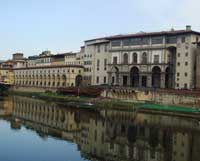
|
|
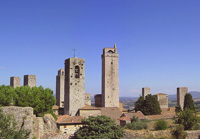 |
|
|
| Vasari Corridor, Florence |
|
San Gimignano |
|
Florence, Duomo |
| |
|
|
|
|
|
|
|
|
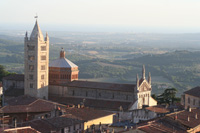 |
Piazza della Santissima Annunziata
in Florence |
|
Siena, Palazzo Sansedoni |
|
Massa Marittima |
| |
|
|
|
|
| |
|
|
|
|
| |
|
|
| |
|
|
|
|
| |
|
|
|
| |
|
|
|
| |
|
|
|
| |
|
|
|
| |
|
|
|
| |
|
|
|







